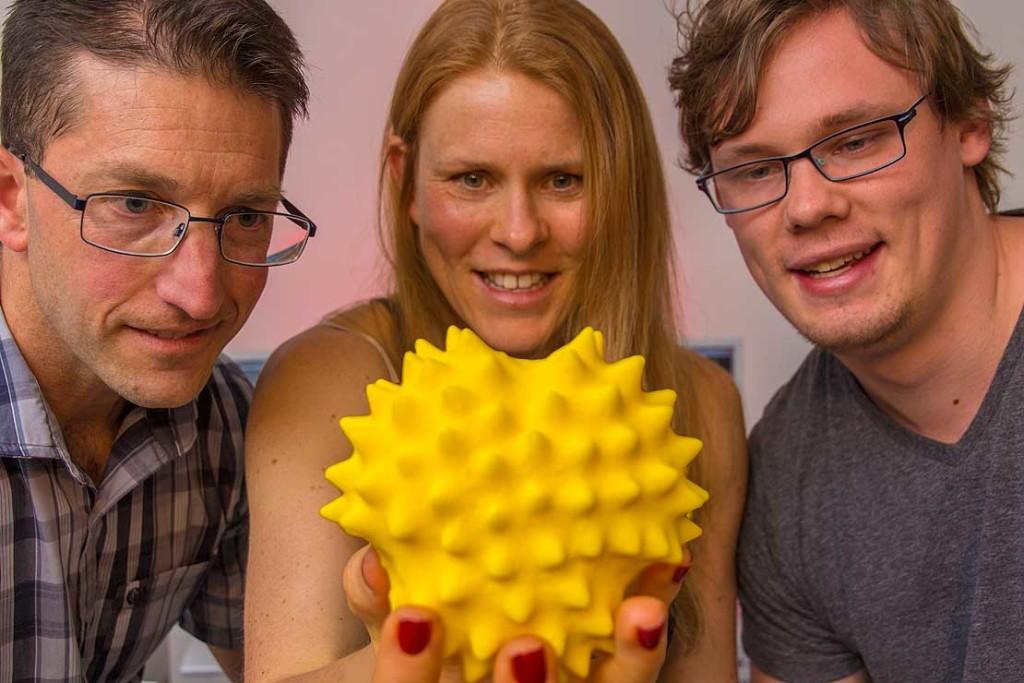If you suffer from allergies, the mere mention of pollen is likely enough to make you shudder. Those tiny yellow particles can cause a lot of pain for something so small. Imagine, then, a single pollen grain the size of your head. Sound like your worst nightmare? Well then, brace yourselves, because Massey University scientists have found a way to blow up pollen particles to thousands of times their original size. The image may be horrifying to you, but be comforted by the knowledge that these particular pollen grains are unlikely to make you sneeze.

(L to R) Dr. Matthew Savoian, Dr. Katherine Holt and Ben Pedersen may be your worst nightmate. [Photo: Massey University]
She worked with Massey University’s Manawatū Microscopy and Imaging Centre, which offers free access to technology including a wide range of microscopes to students and professors. Using a scanning confocal microscope, Dr. Holt created 3D models of four types of pollen granules, from New Zealand native tree species Red Beech, Matai, Mountain Toa Toa and Rangiora. She then enlisted the help of engineering student Ben Pedersen, who improved the quality of the data and the image resolution using a process known as deconvolution.“I had seen people making 3D models of pollen that could then be viewed on a computer,” she said. “I thought, why not take this one step further and print them out in 3D? What surprised me is that it’s a really simple idea but no one had actually done it before.”
 Dr. Holt and Pedersen scaled the pollen grain models up two to three thousand times their original size, and then it was time to print. They experimented with selective laser sintering, which produced a high-resolution model, as well as molten polymer deposition, which resulted in lower resolution. When they were finished, they had an assortment of giant pollen that students could hold and examine in three dimensions, allowing them to see the differing shapes and textures of the pollen species.
Dr. Holt and Pedersen scaled the pollen grain models up two to three thousand times their original size, and then it was time to print. They experimented with selective laser sintering, which produced a high-resolution model, as well as molten polymer deposition, which resulted in lower resolution. When they were finished, they had an assortment of giant pollen that students could hold and examine in three dimensions, allowing them to see the differing shapes and textures of the pollen species.
“I used to use balloons or plasticine to demonstrate pollen morphology to students but there’s something about knowing this is based on the actual thing that makes it amazing,” said Dr. Holt. “It’s a great way to expand our resources for teaching. Anything on the microscopic scale can be blown up, while anything really large, like a mammoth skeleton, can be scaled down. Just imagine: every high school could have their own pollen models or even their own replica moa bones!”
We’ve already seen scientists using 3D printing technology to scale up tiny fossil specimens so that they can be more easily studied, and Dr. Holt’s experiment shows that nothing is too small to be enhanced in this way. Dr. Matthew Savoian, director of the imaging centre, says that the combination of sophisticated microscopes and 3D printing have a lot of potential for every scientific field.
“You might have carbon nanofibres one week and be looking at dairy products the next,” he said. “The wonderful thing about the centre is we can see what’s feasible as well as the limitations of any particular technology.”
Discuss this story in the 3D Printed Pollen forum on 3DPBcom.
Subscribe to Our Email Newsletter
Stay up-to-date on all the latest news from the 3D printing industry and receive information and offers from third party vendors.
Print Services
Upload your 3D Models and get them printed quickly and efficiently.
You May Also Like
Reinventing Reindustrialization: Why NAVWAR Project Manager Spencer Koroly Invented a Made-in-America 3D Printer
It has become virtually impossible to regularly follow additive manufacturing (AM) industry news and not stumble across the term “defense industrial base” (DIB), a concept encompassing all the many diverse...
Inside The Barnes Global Advisors’ Vision for a Stronger AM Ecosystem
As additive manufacturing (AM) continues to revolutionize the industrial landscape, Pittsburgh-based consultancy The Barnes Global Advisors (TBGA) is helping shape what that future looks like. As the largest independent AM...
Ruggedized: How USMC Innovation Officer Matt Pine Navigates 3D Printing in the Military
Disclaimer: Matt Pine’s views are not the views of the Department of Defense nor the U.S. Marine Corps Throughout this decade thus far, the military’s adoption of additive manufacturing (AM)...
U.S. Congress Calls Out 3D Printing in Proposal for Commercial Reserve Manufacturing Network
Last week, the U.S. House of Representatives’ Appropriations Committee moved the FY 2026 defense bill forward to the House floor. Included in the legislation is a $131 million proposal for...



































